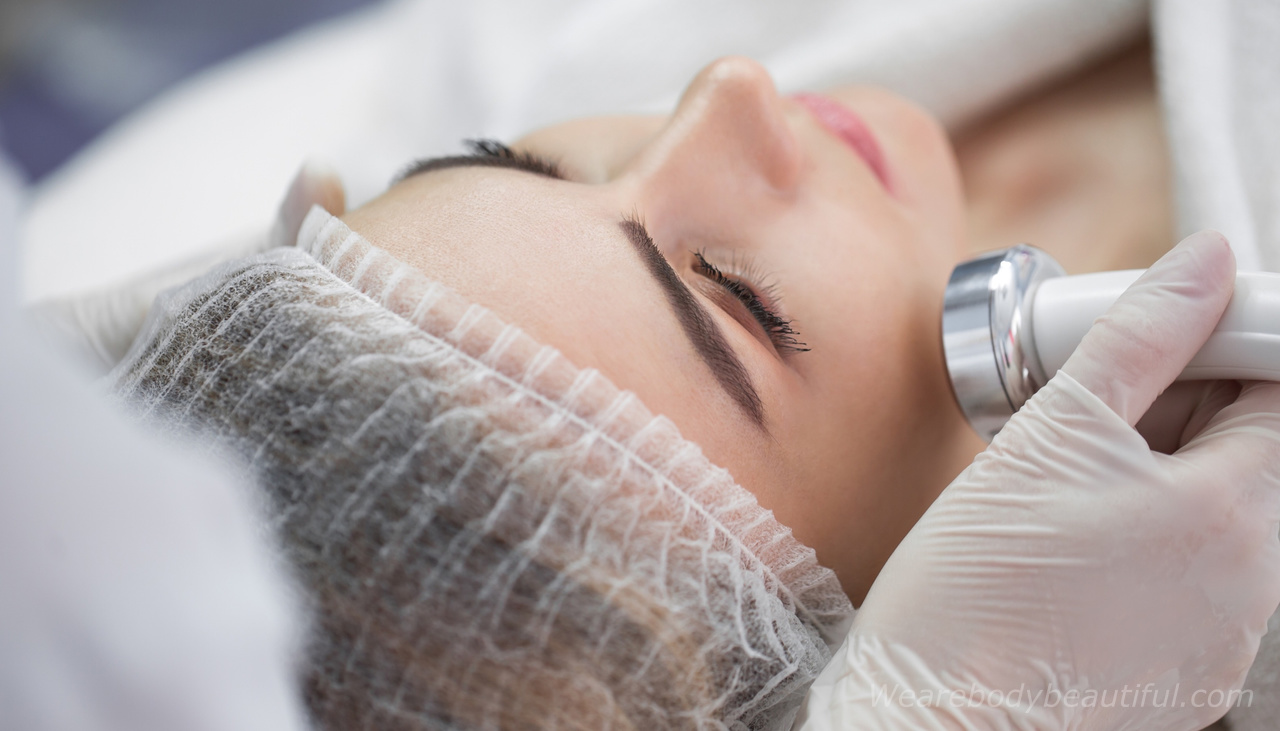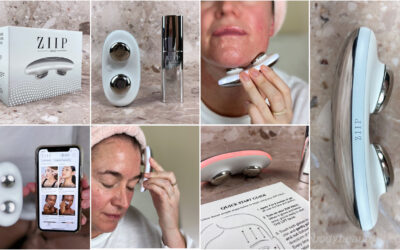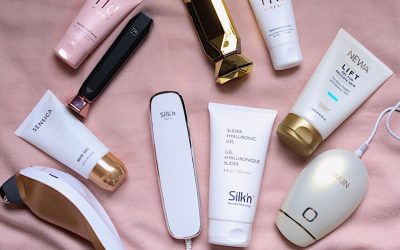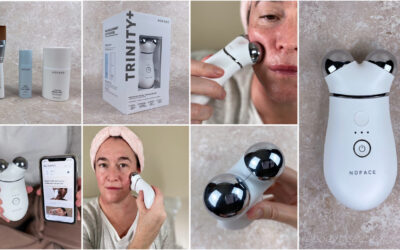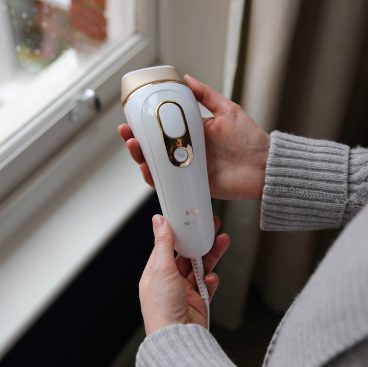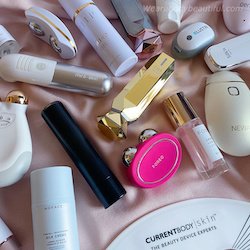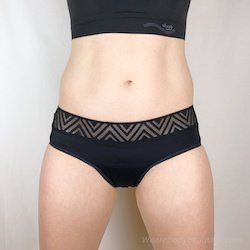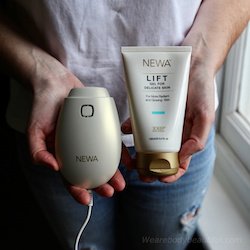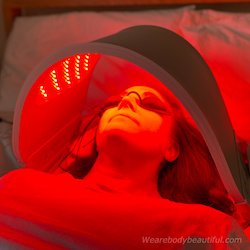A t-home beauty devices using ultrasound waves boost the effects of your skincare products. They do this by a process called phonophoresis. Phonophoresis is a scientifically proven therapy traditionally used in physiotherapy.
Phonophoresis opens pathways in your skin and gets more topical medications (or skincare molecules) deeper down so they work harder and give bigger results. This means home ultrasonic facials can replenish the lost Hyaluronic Acid in your skin due to aging. This is the only technology that can do this. It plumps, firms and smooths for healthy, younger-looking skin.
This article gets into the nitty gritty. We’ll start with how skincare boosting helps, what specific skincare ingredients you need, why Hyaluronic Acid is awesome, how the ultrasound works, and then the proven results.
How does skincare boosting help?
To answer this, we need to understand what’s in anti-aging skincare and how it works with your skin.
Anti-ageing active ingredients
In your anti-aging skincare are several ingredients. Some give the colour, fragrance and texture, or keep them fresh. But others, known as active ingredients, spark specific activity in your skin for lasting anti-aging effects. They help nourish, protect, repair and stimulate your skin.
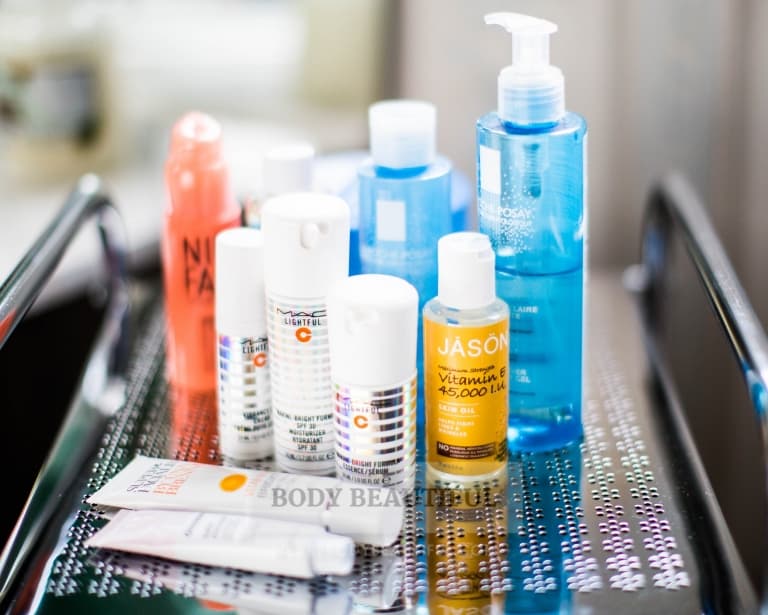
There are various types of active ingredients doing different things. For example:
- Cell-Communicating ingredients are ‘superstar’ ingredients signalling to our skin cells to “behave better”
- Antioxidants are ‘goodie’ ingredients helping your skin to combat collagen-damaging free radicals
- Skin Brightening are ‘goodie’ ingredients that help to fade brownish spots
- Skin-Identical ingredients are ‘goodies’ because they’re found (or mimic things) found naturally in our skin e.g. Natural Moisturizing Factors
- Soothing ingredients lessen skin discomfort
- Anti-acne ingredients help you fight against spots and acne
Source incidecoder.com
For active ingredients to be effective they must get into your skin. Therefore, the first challenge is to pass the protective outer layer.
Your skin’s protective layer
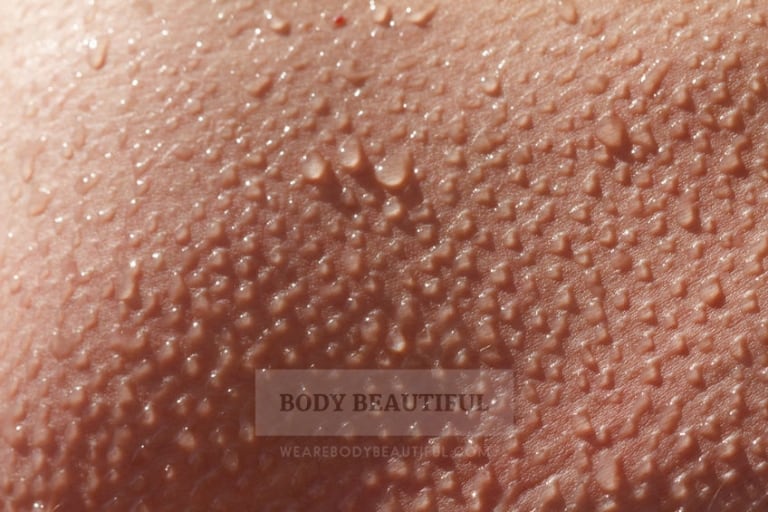
Your skin does an exceptional job of protecting the lower layers.
The outer most layer is the stratum corneum. It’s typically only 10–20μm (micrometres) thick. But the cells (called keratinocytes), are tightly-packed, bonded together and surrounded by a stacked lipid bilayer. These water-insoluble lipids glue the keratinocytes together forming a highly impermeable ‘brick wall’ pattern. This keeps water in and all harmful things out.
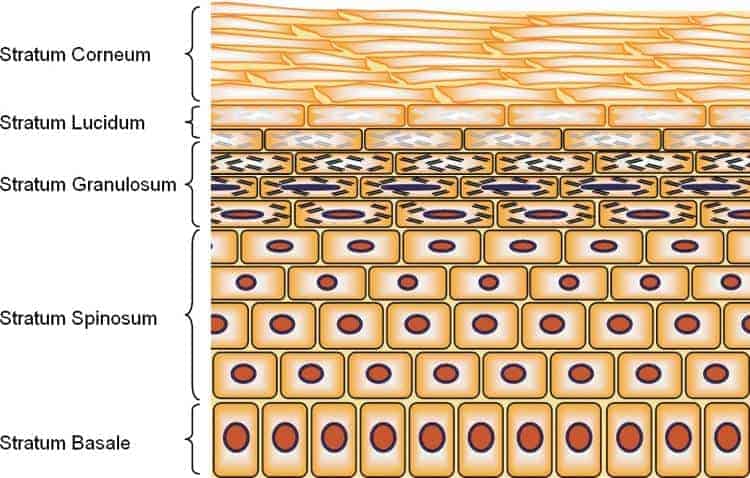
INFO: A micron, also known as a micrometre, is a millionth of a metre. Therefore, 10 to 20 μm depth is 0.01 to 0.02 millimetres. The symbol for microns is μm.
No surprise then, many skincare molecules have trouble passing this protective layer. It slows or stops some entirely. Smaller molecules can sink to the lower layers. But others are too big so they stay on the surface.
Skincare brands spend BIG money developing formulations that get deeper into your skin because they’re more effective. But even with regular use, results are slow and subtle so it’s hard to see any change. Therefore, the cost of premium formulations often just doesn’t seem worth it.
But, if you could only get more concentrated ingredients deeper in your skin, you’d surely notice the difference. And this is what at-home ultrasound devices do.
At-home ultrasound gets even more from the skincare you’ve already invested in.
Let’s learn how it works.
What’s phonophoresis & how does it work?
First, we’ll look at what ultrasound is, then at phonophoresis and how it works to boost your skin’s absorption of medicinal and skincare goodies.
What is ultrasound?
Ultrasound is a sound pressure wave. It oscillates back and forth like a vibration. We measure sound wave frequency in Hertz (Hz). The human ear can hear sound between 20 and 20,000 cycles per second (20 Hz to 20 kHz). Ultrasound frequency is higher than this so we can’t hear it.

Home ultrasound devices uses high frequency ‘soft’ ultrasonic waves at around 1 MHz (1 million oscillations per second) or lower. It’s painless and gentle on your skin. This is the same frequency as commonly practised in physiotherapy for a procedure called Phonophoresis.
INFO: Therapeutic phonophoresis uses high frequency ‘soft’ ultrasonic waves at around 1 MHz (1 million oscillations per second) or lower. It’s sometimes called Sonophoresis too.
What’s Phonophoresis?
Phonophoresis helps your skin better absorb molecules from creams and gels applied on the surface. First studied in the 1950s, it’s an established, safe procedure in physiotherapy. It typically uses ultrasound frequencies of 1 MHz to 3 MHz.
The ultrasonic vibrations temporarily jumble-up the protective outer layer of your skin. This creates bigger gaps so more and larger molecules can pass through. In physiotherapy, it sends helpful medicine molecules – such as pain killers and anti-inflammatory drugs – to the source of pain.
But how exactly does phonophoresis do it?
How does Phonophoresis work?
Disruption of the skin barrier occurs because of acoustic cavitation. It’s thought the ultrasound vibrations form tiny bubbles in between the keratinocyte cells. These then vibrate to jumble it all up and create tiny openings. Skincare molecules then have easier passage through the stratum corneum to the lower skin layers.

The effects are temporary, but the pathways stay open for a while.
TIP: With the Mira-skin home ultrasonic device your skin is extra absorbent for around 30 minutes after your session. Therefore, you can apply more serums and goodies immediately after the ultrasound treatment so more gets deeper into your skin.
Most at-home ultrasound devices partner with their own skincare products. You can use them or your own preferred skincare. But the key ingredient for maximum effect on aging skin is Hyaluronic Acid. Together with the ultrasound boost, you get noticeable skin hydration and plumping effects.
What’s Hyaluronic Acid?
Hyaluronic Acid occurs naturally in our bodies, in our joints, ligaments, skin and eyes.
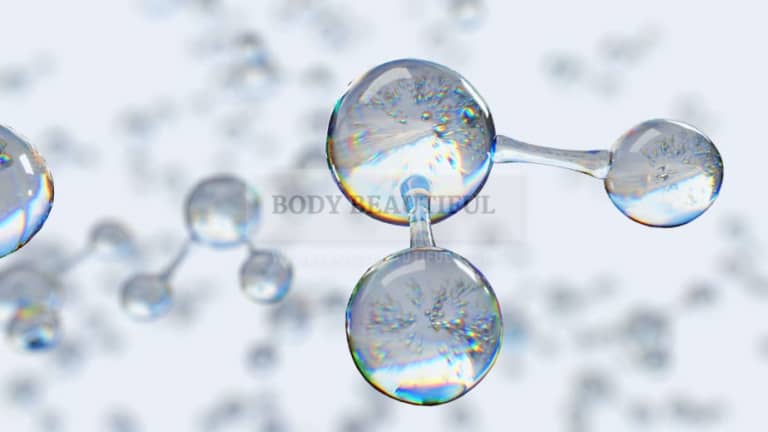
Despite the word ‘acid’, it’s really a sugar molecule. And a clear gel-like goo and a water-loving super-sponge!
Various internet sources say it can hold up to 1000 times its weight in water. No surprise then our bodies use it to hydrate tissues and lubricate joints. 50% of yours is in your skin. It’s found throughout your skin in the dermis (lower) and epidermis (outer) layers.

Along with collagen and elastin, it’s the main molecule in your skin’s extracellular matrix (ECM). The ECM is the scaffold that supports and nurtures your skin cells and keeps it looking young. The water Hyaluronic Acid holds keeps skin firm, smooth and plump. It’s the reason babies and children have such perfect, soft skin.
It’s a very good thing indeed.
Unfortunately, from early adulthood, your Hyaluronic Acid starts a steady decline. This contributes to the first signs of aging in your 30s and 40s. Eventually, it disappears from your epidermis entirely. Yikes. Skin becomes dry, dull, sagging and wrinkled. Boo.
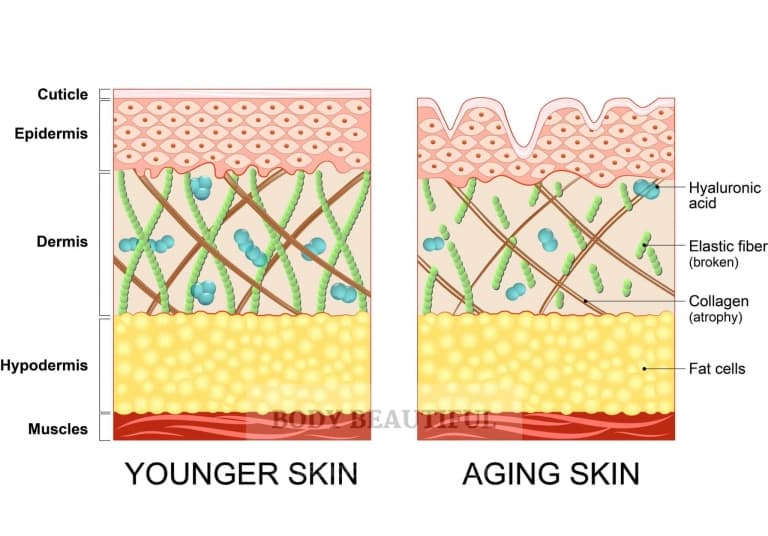
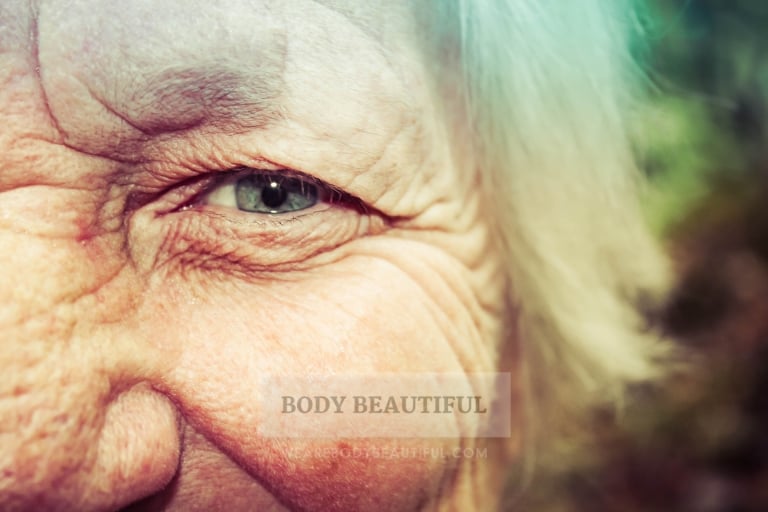
So, replacing what’s lost as we age is a neat idea. And skincare can help here. Hyaluronic Acid is an ‘IT’ ingredient in skincare right now. Let’s learn what it does.
How does Hyaluronic Acid work in skincare?
Hyaluronic Acid is a repeating molecular structure (called a polymer). The subunits can repeat many times as long-chain (or high-molecular-weight), or just a few times as short-chain (or low-molecular-weight).
In its high-weight, long-chain format it’s too big to absorb into your skin. Therefore, it sits on the surface drawing moisture from the air to hydrate and smooth the outer skin layers. It’s an excellent moisturiser. In the world of skincare ingredients, it’s a humectant.
Advanced Hyaluronic serums
However, you can formulate Hyaluronic Acid to be shorter chain. And clinical research shows medium and short-chain molecules sink deeper into the skin. The shorter the chain the deeper they go. They then attract and hold onto more water in the skin. And soap and other cleansers can’t wash them away. Therefore, a good Hyaluronic serum must have molecules of different chain lengths to moisturise all the layers.
And with daily application it builds in your skin. But it takes time.
The shorter chain Hyaluronic Acid molecules stay deeper inside your skin for about a day. Then enzymes break them down. So, it’s a slow-refill process as the molecules steadily increase. This gradually plumps the skin making it firm and bouncy. And over time it subtly smooths fine lines and fills-out wrinkles.
So, partner an advanced Hyaluronic serum with a regular at home ultrasonic phonophoresis boost, and you’ve got a potent combination.
Can I use it?
Phonophoresis facials are very gentle, and very well tolerated. However, there are a few contraindications for home devices to be aware of.
IMPORTANT: Consult your doctor before using an ultrasound skincare boosting device if you’re currently under medical care for a skin condition.

Key checks ✔️
Before you buy a home use device, check:
- You’re not pregnant.
- You’re over 18 years of age
- You DON’T have a pacemaker, heart disease, cardiac arrhythmias or other serious medical condition

Body areas to avoid ❌
Don’t use the ultrasound wand device:
- Internally and avoid the eyes, eyelids, ear and throat (Adam’s apple area)
- More than 10 minutes per treatment. Overuse of ultrasound cleansing tires out the muscles and tissues, and produces undesirable results
- On open sores, wounds or infected areas. Consult a doctor prior to use

Skincare ingredients to avoid ❌
- Nanoparticles
- Essential oils
- Fruit acids
- Enzymes
Results & clinical proof
Therapeutic phonophoresis (1MHz to 3MHz) is clinically proven and regularly practised in physical therapy. However, there aren’t many studies for aesthetic use.
However, there’s one home-use ultrasonic infuser called Mira-skin that has good clinical evidence proving it’s safe and effective. When used with the Mira-skin Hyaluron Serum, the tests show it works to:
✔️ Deeply replenish your lost Hyaluronic Acid
✔️ Diffuse anti-aging active ingredients deeper into your skin fuelling repair and rejuvenation
The visible results of this are:
✔️ Softened lines & wrinkles
✔️ Plumped, smooth, firm & hydrated skin
Additional results depend on other active ingredients in the serum and in your own skincare. So, for example, you need skin brightening ingredients for dark spots. And for a collagen boost you need regenerative and antioxidant actives. Results from the best home ultrasound boost and serum combinations include:
✔️ Faded age spots & redness
✔️ Bright & clear complexion
✔️ Stronger collagen & elastin for healthier skin
In addition, several therapeutic ultrasound studies clinically prove therapeutic ultrasound boosts cell metabolism to support healing. It helps heal muscles, joints and tissue injuries by increasing collagen and elastin. These are the proteins responsible for skin repair and health.
Although open to some discussion, it’s thought the ultrasound gently heats tissue. This doesn’t hurt or damage anything, but it does increase blood circulation to the cells.
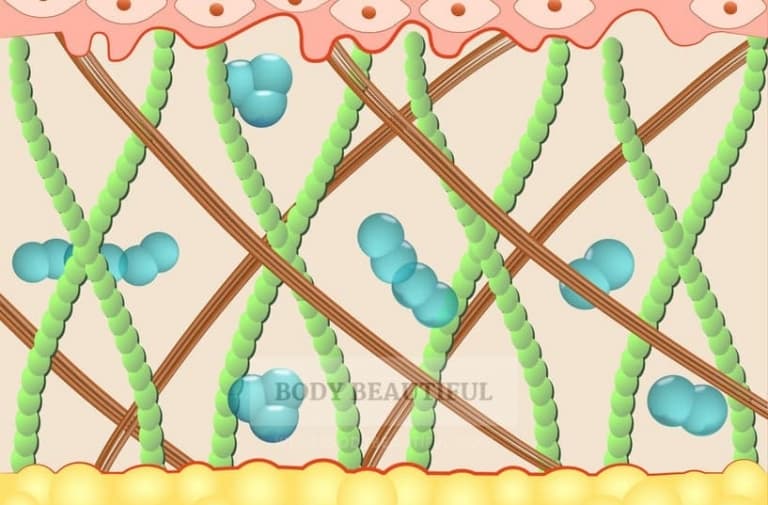
Blood removes waste from your cells whilst delivering oxygen and nutrients. So, with more blood flow sluggish skin cells ‘wake-up’ and start working harder. Each ultrasound session energises them. They build new, stronger collagen and elastin fibres. Gradually, this refreshes your skin making it brighter and more radiant.
So, a further effect of an ultrasound facial is:
✔️ Invigorated skin cells, with renewed collagen and elastin
Your energised cells also make better use of the other deeply-diffused skincare actives. It all combines so regular treatments gradually hydrate, repair and revitalise the layers of your skin.
Phew. So, if you’re still here, you now know everything a phonophoresis facial can do for your skin.
At home ultrasound skincare boosting devices
There’s one device which uses true ultrasound phonophoresis to get more skincare goodies deeper into your skin. It’s called Mira-Skin. Partnered with a good HA serum, it gives impressive skin plumping results, especially on drier and more mature skin that’s lost volume. If you love and invest in high perfoming skincare, you should check out the before and after photos.
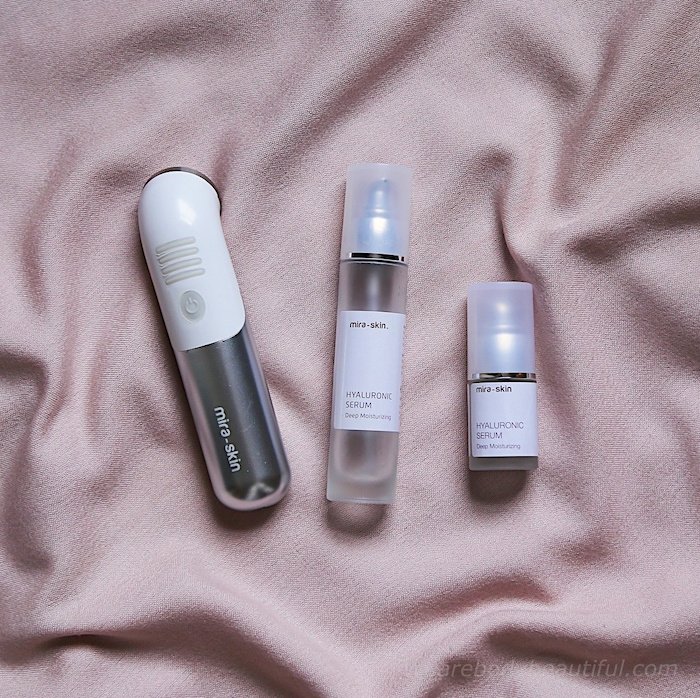
Other brands with fast vibrating cleansers and applicators claim their devices boost your skincare absorption. However, there’s no clinical proof for these devices and they don’t create pathways in your skin like ultrasound phonophoresis.
References and sources
- Ultrasound-Mediated Transdermal Drug Delivery: Mechanisms, Scope, and Emerging Trends,
- Low-Frequency Sonophoresis: Application to the Transdermal Delivery of Macromolecules and Hydrophilic Drugs
- Absorption of Hydrocortisone Acetate in Human Connective Tissue Using Phonophoresis
- A mechanistic study of ultrasonically-enhanced transdermal drug delivery
- Effects of Therapeutic Ultrasound on Intramuscular Blood Circulation and Oxygen Dynamics
- Therapeutic ultrasound: The effects upon cutaneous blood flow in humans
- http://www.justaboutskin.com/skin-barrier-function/
- Hyaluronic acid: A key molecule in skin aging
- ‘Hyaluronic Acid’ incidecoder.com
- Hyaluronan Participates in the Epidermal Response to Disruption of the Permeability Barrier in Vivo
- Efficacy of cream-based novel formulations of hyaluronic acid of different molecular weights in anti-wrinkle treatment.
- http://thebeautybrains.com/2015/03/is-hyaluronic-acid-a-good-anti-aging-ingredient/
- https://www.wellandgood.com/good-looks/guide-to-active-ingredients-for-skin-care-issues/slide/3/
- https://www.heypretty.com/beauty-abc-all-about-actives-in-skincare/

